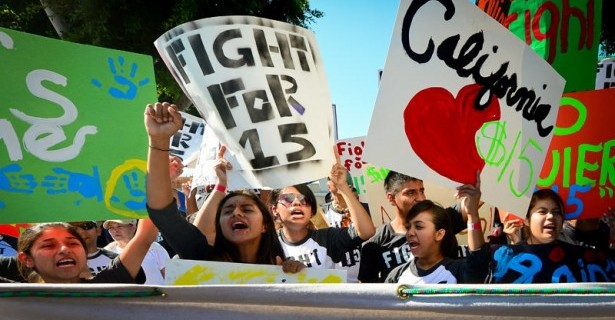Fight for 15 Confidential

On August 29, fast-food workers and supporters gathered outside a Los Angeles McDonald’s to take part in a nationwide strike. Photo courtesy of Frederic J. Brown.
The Service Employees International Union (SEIU)-backed campaign to organize fast-food workers nationwide is on a roll. It’s entering its second year in the public eye, having staged four one-day strikes, culminating in a 60-city walkout on August 29.
SEIU says its role has been more servant than shepherd. “It’s really a privilege for us to support” fast-food workers, SEIU President Mary Kay Henry told Salon’s Josh Eidelson in August. Henry portrayed the campaign as a surprise: “We don’t yet understand the scale of it,” she said, adding that she was “amazed at the degree to which it spread.”
So who’s calling the shots? To find out, In These Times talked to 40 low-wage workers, labor organizers, reporters, historians, union officials and media strategists.
They made clear they do support Fight for 15—often enthusiastically—for providing space for workers to build relationships, share knowledge and, in some cases, embark on shopfloor organizing. But many questioned whether Fight for 15 is fundamentally a worker organizing campaign or a “march on the media,” and many believe the endgame will be determined by an SEIU leadership that is not in contact with the daily realities of the campaign.
How Chicago’s campaign took off
Sam (not his real name), a cashier at a health-food store, says the Chicago Teachers Union strike in September 2012 opened space to discuss work-related issues with his coworkers, as did a strike the next month by warehouse workers just west of Chicago and the nationwide Black Friday strikes at Wal-Mart stores staged by the UFCW-backed OUR Walmart campaign.
Looking for assistance in early 2013, Sam and co-organizers started attending meetings of the SEIU-staffed Worker Organizing Committee of Chicago, which was formed in November 2012 to lead Fight for 15, the Chicago chapter of the national fast-food campaign.
Sam and his co-worker Jason (not his real name) say they initially found some tactics off-putting. The decision to stage the first low-wage worker walkout in Chicago on April 24 was made a few weeks in advance, at a meeting where New York workers were flown in to talk to the Chicago workers. After a rousing description of the New Yorkers’ experience walking off their jobs, Jason says, the Fight for 15 organizers asked, “ ‘Who wants to go on strike?’ Everyone cheered, and of course we want to go on strike after you hear what they just said. They called it a strike vote, but it wasn’t a vote in any meaningful way.”

SUPPORT LABOR NOTES
BECOME A MONTHLY DONOR
Give $10 a month or more and get our "Fight the Boss, Build the Union" T-shirt.
Following the April 24 strike, workers demanded a greater say in meetings. The next decision to strike, in mid-July, was a vote with a 30-minute discussion and a count of those for, against and abstaining. It passed overwhelmingly. “It represented a very big step forward in terms of the actual practices within the union,” says Jason. Now, up to 200 workers attend meetings in Chicago every other week.
Outside of Chicago, however, there’s little evidence of worker-to-worker organizing. In Seattle and Washington, D.C., sources say active workers number a dozen or less, about the same as the number of paid organizers.
Whither the campaign?
Despite the uneasiness some organizers have about SEIU’s role, others doubt that a truly spontaneous, worker-led uprising would have been possible without SEIU leadership.
“Without SEIU this shit would not have happened,” Marco says. “Fast-food workers are not going to self-organize. They’ve been so beat down for so long by circumstances and an anti-labor environment. You look at the Civil Rights Movement—a lot of that was top-down, orchestrated movement.”
Excerpted with permission from In These Times magazine. Read the full story here. Copyright 2013.
Arun Gupta is co-founder of the Occupy Wall Street Journal and a founding editor of the award-winning grassroots New York City newspaper The Indypendent.
